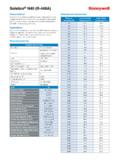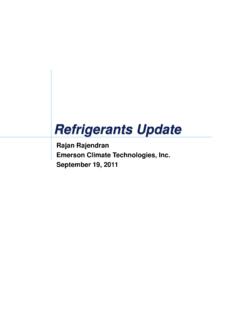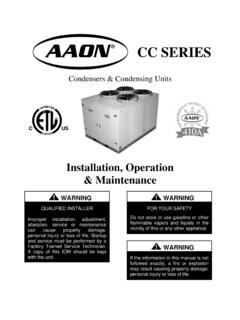Transcription of Latest Developments of Low Global Warming Refrigerants for ...
1 2595, Page 1 International Refrigeration and Air Conditioning Conference at Purdue, July 16-19, 2012 Latest Developments of Low Global Warming Refrigerants for Chillers Mark W. Spatz1*, Ankit Sethi2, Samuel Yana Motta3 Honeywell International, Buffalo Research Laboratory, Buffalo, NY, USA 3 * Corresponding Author ABSTRACT This paper will focus on the Developments of new molecules that have low Global Warming potential, high thermal performance, and favorable safety characteristics, to name only a few required characteristics. Several new molecules that have very short atmospheric lifetimes, as well as refrigerant blends utilizing these molecules, have been developed and will be evaluated for use in various types of water chillers ranging from smaller capacity systems that currently use R- 410a or R-407C Refrigerants to larger centrifugal compressor chillers that have currently used R-134a or R-123.
2 Thermodynamic and system simulations were carried out using low GWP refrigerant properties and compared against the baseline Refrigerants . These new LGWP Refrigerants show promise in these applications and warrants further development. Keywords: Refrigerants , Global Warming , Hydro-fluoro-olefins 1. INTRODUCTION Refrigerants that are in common use today, HFCs, have the benefits of high energy efficiency, safety in use, properties that enable the design of cost effective systems, and from an environmental perspective they have no impact on stratospheric ozone. Despite these attributes, the air conditioning and refrigeration industry is now looking for replacements due to the growing Global concerns around climate change since many of these Refrigerants have relatively high Global Warming potential.
3 New molecules with the positive attributes of both high thermal performance and low environmental impact, not name a few necessary characteristics, are currently in development. These materials maintain the high level of system efficiency we are accustomed to with fluorocarbon Refrigerants but with significantly lower Global Warming impact than current Refrigerants . They also exhibit significantly lower flammability characteristics than the much more flammable hydrocarbons. Replacements for Refrigerants used in chiller systems that employ DX heat exchangers as well as flooded ones will be discussed. Chemical and physical properties as well as experimental results in representative equipment will be presented.
4 Two new low GWP refrigerant molecules (HFO-1234yf, HFO-1234ze) have been identified. These molecules are Hydro-Fluoro-Olefins (HFO) that due to their very short atmospheric life times of 11 and 18 days have an extremely low Global Warming potential (GWP) of only 4 to 6 (as compared to 1430 for R-134a). Also under development is another low Global Warming molecule (GWP < 10) that has properties that potentially enable its use in low pressure chillers. In addition, we are in the process of developing and evaluating refrigerant blends that balance the attributes of higher capacity and low Global Warming potential while maintaining the efficiency of present systems without significant increases in system cost.
5 This study will discuss properties and performance of potential refrigerant options in positive displacement and centrifugal chiller systems often used in air conditioning applications. 2595, Page 2 International Refrigeration and Air Conditioning Conference at Purdue, July 16-19, 2012 2. WORKING FLUIDS Depicted in Table 1 are potential low Global Warming molecules as well as a reference higher Global Warming molecule, R-134a. Also shown in Table 1 are Permissible Exposure Limits (PEL) and flammability limits (LFL and UFL). It should be noted that Refrigerants that do perform well in certain applications where R-134a is used will not perform well in all applications, such as smaller capacity chillers where Refrigerants with higher volumetric capacity, higher pressure, and other distinct properties are used.
6 It is for this reason that refrigerant blends that are better suited for applications that use higher capacity/higher pressure Refrigerants are currently in development. Table 1: Certain refrigerant Properties refrigerant GWP PEL (ppm) LFL / UFL (Vol%, 23 C) R-134a 1430 1000 - HFO-1234ze 6 800 - HFO-1234yf 4 400 R-32 675 1000 R-600a ~5 800
7 R-290 ~5 1000 In addition to the refrigerant molecules listed above, another single component refrigerant , named N-12, is also under development for low pressure chillers and other applications. This molecule has a very low GWP of less than 10 and is non-flammable. Blends with significantly lower GWP than current Refrigerants are currently in development and have been discovered to have performance characteristics close to R-404A, R-22, and R- 410a and offer a GWP reduction of 75% to 95% relative to the refrigerant it replaces. Table 2: Honeywell s Refrigerants Options N SeriesL Series Current Product Reduced GWP Option ( A1)Lowest GWP Option (A2L)R-404A GWP=3922 HFO Blend GWP~1300 (retrofit) N-40 HFO Blend GWP~1000 (new equip) N-20 HFO Blend GWP~200-300 L-40 HCFC-22 GWP=1810 HFO Blend GWP ~1000 N-20 HFO Blend GWP <350 L-20R- 410a GWP=2088 HFO-Blend GWP <500 L-41 HFC-134aGWP=1430 HFO Blend GWP ~600 N-13 HFO-1234yf GWP = 4 L-YFHFO-1234ze GWP = 6 L-ZER-123 GWP= 77 HFO GWP =7 N-12 2595, Page 3 International Refrigeration and Air Conditioning Conference at Purdue, July 16-19, 2012 3.
8 POSITIVE DISPLACEMENT chiller APPLICATIONS A performance analysis was carried out for an air cooled 20 ton (70 kW) chiller using a lumped parameter modeling approach for the heat exchangers. The water inlet and outlet temperatures were assumed to be 12oC and 7oC respectively. The analysis was performed at an ambient air temperature of 35oC. The evaporator superheat and condenser subcooling were set at An assumption was made that the volumetric and isentropic efficiencies were the same for all Refrigerants . Performance results obtained for R- 410a alternatives with our analysis are shown in Table 3. Performance results obtained for an alternative to R-407C with our analysis are depicted in Table 4.
9 Table 3: Positive Displacement chiller Analysis R- 410a Alternatives Results Tevap (oC) Tcond (oC) Psuction (kPa) Pdischarge (kPa) dPcond (kPa) dPevap (kPa) Mass Flow (kg/s) Capacity (kW) COP R410A 70 20 L-41 (Drop in) Comparison L-41 (Circuits mod.) Comparison L-41 (Comp. mod.) Comparison Since drop-in performance of L-41 into the R- 410a system showed a significant drop in mass flow rate and pressure drops, the number of circuits in the evaporator was decreased by 23% and in the condenser by 13% to increase the mass velocity for L-41.
10 This led to increase in capacity and COP of the system due to improvements in heat transfer. The capacity was fully recovered when the compressor displacement was increased by 8% and the number of circuits was decreased by 18% in the evaporator and by 11% in the condenser. Table 4: Positive Displacement chiller Analysis R-407C Alternatives Results Tevap (oC) Tcond (oC) Psuction (kPa) Pdischarge (kPa) dPcond (kPa) dPevap (kPa) Mass Flow (kg/s) Capacity (kW) COP R407C 70 20 L-20 Comparison Table 4 shows drop-in evaluation of L-20 as replacement of R407C in a air-cooled chiller .














